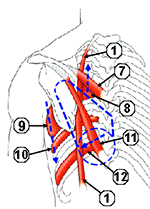 The scapular (shoulder blade) muscle 1st round portion of Trapezius (7), and its associated rib muscle, the 6th Intercostal (8), are stressed by being attached to the vertebra at which the back changes direction and slumps forward. Exaggerated shoulder slumping occurs from the slump point to the head. The nerve they irritate can give sharp pain as though a pin were stuck in this point. The involved rib muscle may make the pin feel as though it is stuck all the way through to the breast bone. Throwing the head and shoulders back often provides temporary relief. Pulsing 7 and 8 will bring real, lasting relief. The scapular (shoulder blade) muscle 1st round portion of Trapezius (7), and its associated rib muscle, the 6th Intercostal (8), are stressed by being attached to the vertebra at which the back changes direction and slumps forward. Exaggerated shoulder slumping occurs from the slump point to the head. The nerve they irritate can give sharp pain as though a pin were stuck in this point. The involved rib muscle may make the pin feel as though it is stuck all the way through to the breast bone. Throwing the head and shoulders back often provides temporary relief. Pulsing 7 and 8 will bring real, lasting relief.
Last, or 8th Digitation of Serratus Anterior (9), is the bottom of the muscle that attaches the scapula, or shoulder blade to the ribs. It is stressed by having to stabilize the shoulder while the arm does heavy work.
The rib muscle 8th Intercostal (10) is thrown into torsion stress by 9 pulling up on the rib. This stress on 10 adds the "catch" at the point where 1 crosses it, just inside the lower angle of the scapula.
The 2nd round portion of Trapezius (11), also a scapular muscle, and its associated rib muscle, the 10th intercostal (12), attach to the 10th vertebra which is at the level of the bottom of the lungs. This is a reflex point from and to the bronchioles. If you have asthma or bronchitis, pulse the circled area.
At this same level, the Illiocostalis transfers irritation to the Longissimus Thorascis (51) coming up from below at (13).
|

